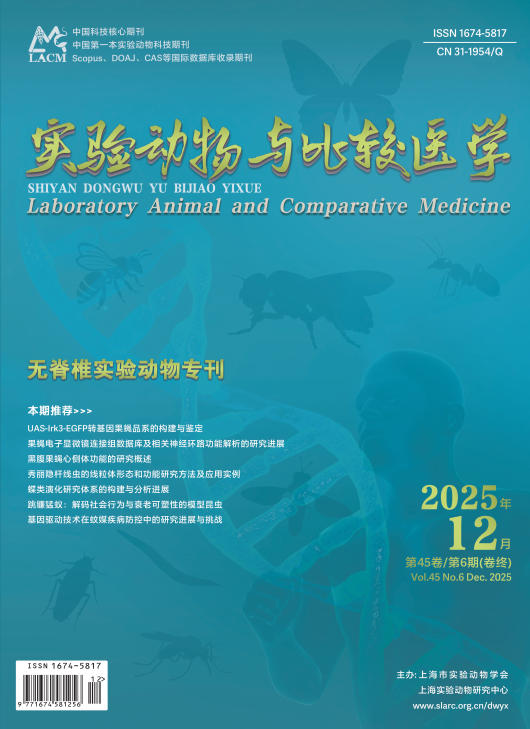-
Chronic Toxicity Study on Deinococcus Radiodurans R1 in Rats
- XU Qin, WANG Wei, DONG Xiang, LI Jianying, SHI Wenhui, LIU Xiaolu, LIU Aizhong, MA Na, SONG Laiyang, LIU Jiangwei
-
2021, 41(4):
333-342.
DOI: 10.12300/j.issn.1674-5817.2020.213
-
 Asbtract
(
647 )
Asbtract
(
647 )
 HTML
(
13)
HTML
(
13)
 PDF (14608KB)
(
297
)
PDF (14608KB)
(
297
)
-
Figures and Tables |
References |
Related Articles |
Metrics
Objective To observe the chronic toxicity of Deinococcus radiodurans R1 (DRR1) in SD rats.Methods SD rats were divided randomly into 5 groups: 109/mL live DRR1 group (LDRH), 107/mL live DRR1 group (LDRL), 109/mL DRR1 broken products group (BDRH), 107/mL DRR1 broken products group (BDRL), and agar medium including 0.5% tryptone, 0.1% glucose and 0.3% yeast agar medium as control group (TGY), and 16 rats in each group with half males and half females. The rats were gavaged once a day for consecutive 30 days,and then 8 rats in each group were randomly selected, and anaesthetized intraperitoneally with 3% pentobarbital sodium 0.15 mL/100 g body weight, the blood and organ samples were collected to analyze blood routine, serum electrolyte, serum biochemical indexes and organ coefficients. The heart, liver, kidney and lung of LDRH and BDRH group rats were fixed with 10% neutral formaldehyde (V/V), stained with Hematoxylin-eosin and examined by optical microscope to analyze the toxicity of DRR1. The delayed toxicity effect of DRR1 was performed on the 14 th day after drug withdrawal, by the same way as above groups. The behavior, food intake and body weight of rats were observed after administration and recovery period.Results After 30 days of administration with different concentrations of DRR1 living bacteria and its fragments, at the point of drug withdrawal 0 d and 14 d, no abnormal movement and respiration were observed, no abnormal phenomena such as slow reaction, pupil change, eyeball protrusion and skin color change were observed; no abnormal secretion was found in mouth, ear, nose and eye corner; no abnormallities were found in urination and defecation and stool morphology. Compared with TGY group, the food intake, body weight and organ coefficient of the DRR1 groups had no significant changes. The number of white blood cells (WBC) in LDRH, decreased significantly on the 30 th day of administration (P < 0.05), and returned to the TGY group level after 14 days of drug withdrawal. The number of red blood cells, hematocrit and hemoglobin had no significant changes, the number of lymphocytes, granulocytes, monocytes and their percentages had no significant changes, and the number of platelets had no significant changes. The serum alanine aminotransferase (ALT), alkaline phosphatase (ALP), total protein (TP), uric acid (UA), urea (UREA), blood glucose (Glu), phosphorus (P) and magnesium (Mg) were not significantly changed after drug withdrawal. The levels of aspartate aminotransferase (AST), creatine kinase (CK), creatine kinase MB (CK-MB) and lactate dehydrogenase (LDH) in LDRH group were significantly increased (P < 0.05). After 14 days of recovery, AST and CK decreased to the level of TGY, CK-MB was still higher than that of TGY group (P < 0.05); LDH in the recovery period was significantly higher than that 0 h after drug withdrawal (P < 0.05), no significant change compared with recovery period TGY group. There was no significant change in serum ion concentration (P > 0.05) on the 30th day of administration. On the 14th day after drug withdrawal, Cl- and Ca2+ decreased, Na+ and pH increased (P < 0.05) in LDRH group. No significant pathological changes were found in heart, liver, lung and kidney of LDRH and BDRH group.Conclusion DRR1 live bacteria and its bacterial fragments are practically non-toxic on rats. This study provides experimental data for the application of DRR1.
-

